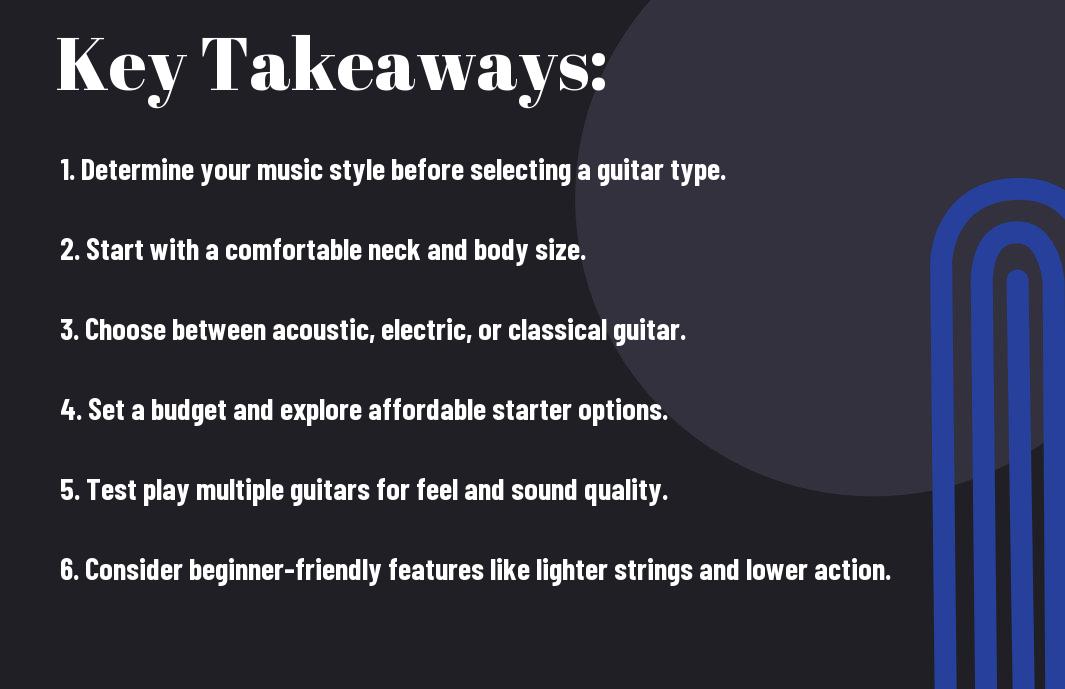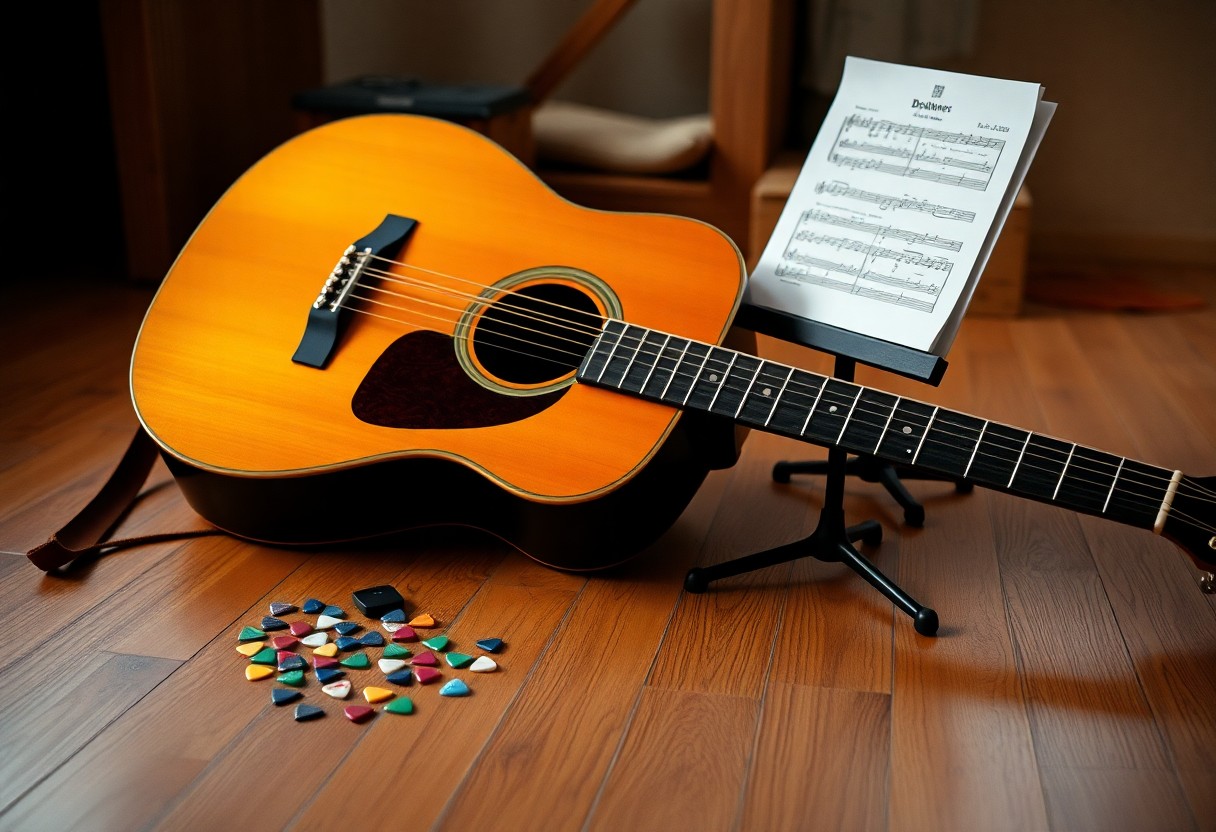Beginner guitarists often feel overwhelmed by the vast selection available, and I understand how challenging it can be to make the right choice. When deciding on your first guitar, it’s important to consider the type of music you want to play, your budget, and whether you prefer acoustic or electric models. Choosing the wrong instrument can lead to frustration and a lack of motivation, so take your time. I will guide you through the necessary features to look for and help you find the perfect guitar that resonates with your style and passion.

Decoding Your Musical Aspirations
Understanding your musical aspirations is vital for selecting the right guitar. Knowing what you want to achieve will guide your choice, whether that’s strumming along with friends, composing original pieces, or performing on stage. Your goals can shape the type of guitar you need, including whether to invest in an acoustic for softer sounds or an electric for a more robust, expressive tone.
Identifying Your Musical Style
Your musical style directly impacts your choice of guitar. If you lean toward rock, pop, or metal, an electric guitar might suit your sound better. In contrast, if you appreciate folk, blues, or country, an acoustic instrument might be more aligned with your interests. Explore various genres to determine which resonates with you most.
Matching Equipment to Genre
Selecting the right equipment means considering how different guitars complement specific genres. For example, rock and metal enthusiasts will thrive with electric guitars equipped with powerful pickups, capable of delivering the heavy distortion and sustain required for those styles. On the other hand, acoustic guitars excel in folk, country, and singer-songwriter genres, offering warmth and clarity that brightens the sound in more laid-back settings. By understanding these nuances, you can find the guitar that elevates your performance and aligns with your musical aspirations.
Navigating the Guitar Landscape: Acoustic vs. Electric
Key Differences and Similarities
Acoustic and electric guitars each offer unique characteristics that cater to different musical styles and preferences. Acoustic guitars produce sound through the natural vibration of their strings and body, while electric guitars rely on electronic amplification to produce sound. Both types are versatile as they can be used in various genres, yet they often present different playing experiences. Acoustic guitars are ideal for solo performances and songwriting, while electric guitars shine in band settings and elaborate solos.
Pros and Cons of Each Type
Choosing between an acoustic and electric guitar involves weighing their advantages and drawbacks. Below is a breakdown of the pros and cons of each type:
Pros and Cons of Each Type
| Acoustic Guitar | Electric Guitar |
|---|---|
| Portable and easy to set up | Versatile sound options with effects |
| Great for playing in any environment | Ideal for live performances with amplification |
| More suitable for fingerstyle and strumming | Allows for advanced techniques like tapping |
| Less expensive to start with | Can produce a wider range of genres |
| No need for additional equipment | Can enhance creativity with effects pedals |
| Wooden body adds warmth to the sound | Thin body gives easier access to higher frets |
| Good choice for singer-songwriters | Often comes with built-in effects |
| Can be challenging for beginners to play | May require maintenance for electronics |
| Limited sound manipulation | Can be expensive due to additional gear |
| Sound may not cut through a mix | Heavier and less portable than acoustic |
The decision between an acoustic and electric guitar ultimately depends on your goals and preferences. If you’re after straightforwardness and portability for casual playing, the acoustic guitar might be your best bet. However, if you wish to explore a variety of sounds, effects, and play in a band, the electric guitar offers a more diverse range. Take some time to evaluate what kind of music inspires you the most and how you envision your playing experience.
The Budget Battlefield: Setting Your Financial Limits
Determining your budget helps narrow down your options significantly. Start by deciding how much you’re willing to spend, keeping in mind that quality instruments often come at a higher price. Set a realistic range, factoring in both your current financial situation and how dedicated you are to learning the guitar. It’s possible to find decent entry-level guitars for around $200 to $600, which can provide a strong foundation without breaking the bank.
Balancing Cost and Quality
Finding that sweet spot between cost and quality is crucial. Cheaper models may save you dollars now, but they can lead to frustration down the road if they don’t hold up or sound good. I recommend trying various guitars in-store to ensure you’re getting an instrument that feels right and sounds satisfactory, despite the price tag.
Hidden Expenses in Guitar Ownership
Owning a guitar goes beyond the initial purchase price. Accessories like picks, a strap, spare strings, and a tuner quickly add up. You might also want to factor in lessons, maintenance, and insurance. Setting aside an additional 20-30% of your budget for these costs can save you from surprises later.
When calculating your total investment, consider expenses you might overlook at first glance. For instance, good quality strings, which need regular replacements, cost around $10-$20 for a set. Amplifiers, cases, and even software for recording or learning can stretch your budget further. Moreover, if you’re not handy with repairs, service fees for adjustments or fixing issues can set you back another $50-$100. Factoring in these potential hidden expenses ensures that you’re fully prepared for the journey ahead.
The Touch and Feel Test: Importance of Playability
Your first guitar should feel comfortable and natural in your hands. Playability is a vital aspect that can significantly influence your learning experience. When you pick up a guitar, it should resonate positively in your hands, allowing effortless transitions between chords and techniques. The right instrument will inspire you to practice more, rather than hindering your enthusiasm. For a deeper understanding of what to look for, check out the Buying Guide: How to Buy Your First Guitar – School of Rock.
Exploring Neck Profiles and String Action
The neck profile plays a significant role in dictating how easily you can navigate the fretboard. Guitars come with various neck shapes, from C-shaped to U-shaped, each catering to different hand sizes and playing styles. Additionally, string action—the height of the strings from the fretboard—affects how easily you can press down the strings. Lower string action can make playing smoother, but it may lead to fret buzz if it’s too low. Finding the right balance here is crucial for comfort and playability.
Finding Your Comfort Zone
Finding your comfort zone means experimenting with various types of guitars to see which one feels right for you. Consider factors like body shape, weight, and the guitar’s overall dimensions. I spent time testing different guitars to see how they resonated with my playing style. Whether I preferred instruments that felt lightweight and easy to maneuver or heavier guitars that provided a certain depth, each choice shaped my playing experience. Don’t hesitate to sit down with a range of styles and sizes and play your favorite chords, riffs, and scales until you discover what feels most natural.
The Allure of Brand: Recognizing Trusted Names
Exploring well-known guitar brands can make your selection process smoother. Names like Fender, Gibson, and Yamaha have established a legacy in the music industry, giving them a reputation that speaks to quality and craftsmanship. Selecting a trusted brand often eliminates doubts about whether your guitar will perform well over time. Delving into these established names opens the door to instruments backed by years of expertise and innovation, making the prospect of playing feel a little more reliable.
Evaluating Brand Reputation and Reliability
Identifying a brand’s reputation involves researching its history, craftsmanship, and endorsements from professional musicians. Brands that have stood the test of time often have a loyal following, which typically indicates a superior product. Look for reports of long-lasting builds, customer satisfaction ratings, and warranties offered, as these aspects contribute to the brand’s reliability. A well-regarded brand often reflects quality manufacturing processes that enhance your playing experience.
The Role of Reviews and Recommendations
Consumer reviews and recommendations from fellow musicians can provide valuable insight when selecting a guitar. Websites and forums dedicated to music gear often feature user accounts and experiences that can highlight specific strengths or weaknesses in brands and models. Tasks like comparing ratings across platforms help gauge the guitar’s performance from the perspective of others who have put it to the test. Often, the insight from those who have walked the same path I’m currently on can either confirm or challenge my choices, enhancing my decision-making process.
When sifting through reviews, I focus on multiple sources to get a well-rounded view. Platforms like YouTube feature demonstrations and detailed breakdowns, while online music retailers often aggregate user feedback, giving you an idea of the guitar’s sound quality and durability. Pay close attention to patterns in comments; if several musicians mention a specific issue, it may be worth considering. Likewise, glowing recommendations can often pinpoint standout features that resonate with players. Trusting this collective wisdom can transform your shopping experience from daunting to enlightening, ensuring you choose a guitar that truly fits your needs.
Summing up
Hence, choosing your first guitar is an exciting journey. I encourage you to consider your musical preferences, budget, and comfort when selecting an instrument. You should try various styles and sizes to find the perfect fit for your hands and playing style. Don’t rush—take your time to choose the guitar that resonates with you the most. Your first guitar can influence your musical journey, so make it a choice that inspires you to play and grow as a musician.




